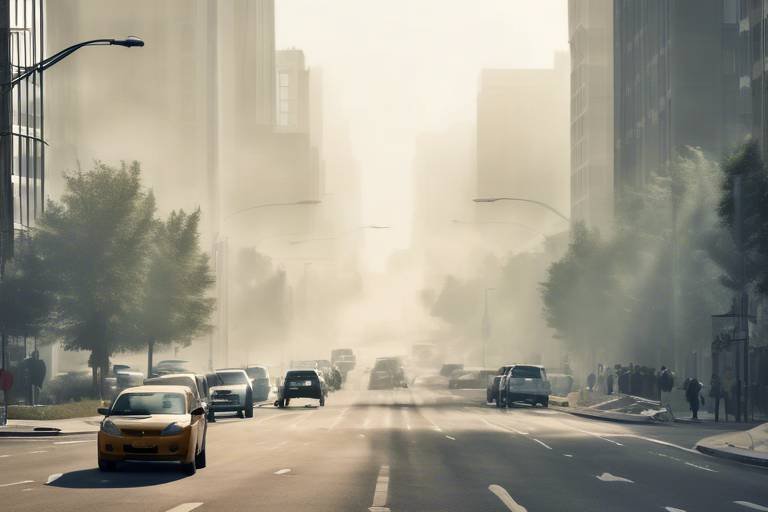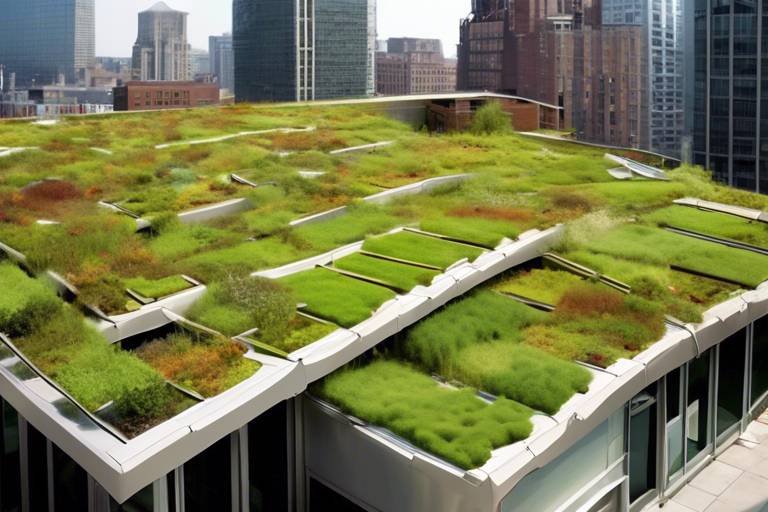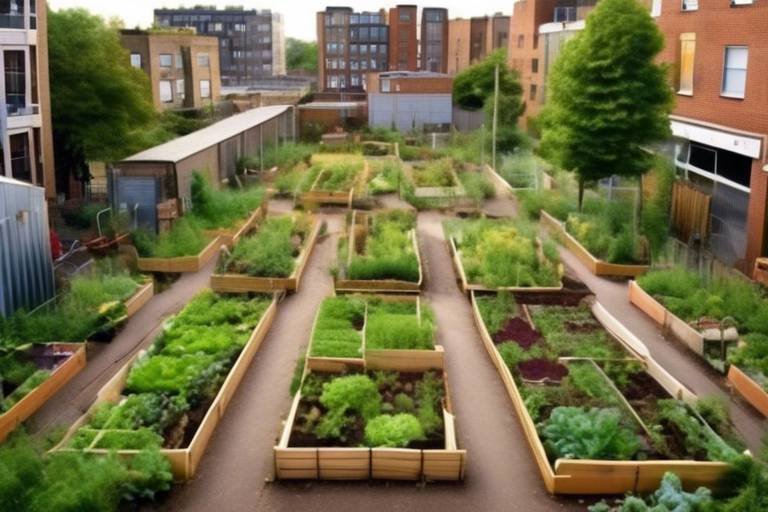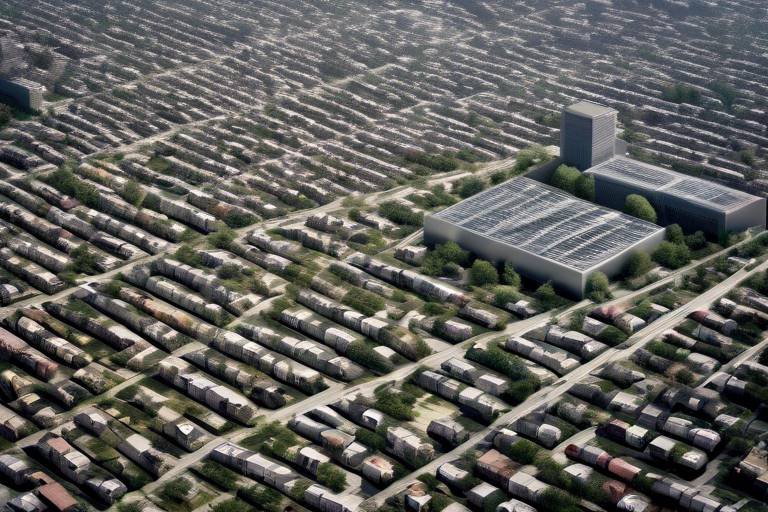Strategies to Improve Air Quality in Urban Areas
This article explores effective strategies for enhancing air quality in urban environments, focusing on practical solutions, innovative technologies, and community engagement to create healthier living spaces for all residents. With the rapid growth of urban populations, the challenge of maintaining clean air has become increasingly urgent. Cities are often bustling hubs of activity, but they can also be hotbeds for pollution. So, how can we tackle this pressing issue? By adopting a multi-faceted approach that integrates technology, community involvement, and sustainable practices, we can pave the way for a cleaner, healthier future.
Urban air pollution is a significant health concern affecting millions. The sources of these pollutants are varied—ranging from vehicular emissions and industrial discharges to construction dust and even household products. Each of these elements contributes to a toxic cocktail that can lead to serious health problems, including respiratory issues, cardiovascular diseases, and even premature death. The impact of air pollution extends beyond individual health; it also affects the environment, contributing to climate change and the degradation of natural ecosystems. Understanding these sources is the first step toward effective solutions.
Implementing green infrastructure, such as parks and green roofs, can significantly improve urban air quality. Integrating nature into city planning not only beautifies the environment but also provides essential benefits for air purification. For instance, trees and plants naturally filter pollutants, absorb carbon dioxide, and release oxygen. Imagine walking through a park in the middle of a bustling city; the fresh air and natural surroundings can be a breath of fresh air—quite literally! By prioritizing green spaces, urban planners can create healthier environments that promote well-being.
Urban forests play a crucial role in filtering pollutants and providing shade. Increasing tree canopy cover can enhance air quality and community well-being. Trees act as natural air filters, capturing dust, smoke, and other particulate matter. Furthermore, they cool the urban heat island effect, which is a phenomenon where urban areas become significantly warmer than their rural surroundings. This cooling effect reduces the need for air conditioning, thereby lowering energy consumption and associated emissions. A well-planned urban forest can be a game-changer in the fight against air pollution.
Trees absorb carbon dioxide and release oxygen, improving air quality. Specific tree species can be more effective than others in this regard. For example, species like the Red Maple and Silver Birch are known for their high pollutant absorption rates. Here’s a quick look at some benefits:
| Tree Species | Pollutant Absorption | Oxygen Production |
|---|---|---|
| Red Maple | High | Moderate |
| Silver Birch | Moderate | High |
| Oak | High | High |
As we can see, not all trees are created equal when it comes to improving air quality. The right selection can lead to greater benefits for urban environments.
Engaging the community in tree planting initiatives fosters a sense of ownership and responsibility. When local residents participate in planting trees, they not only contribute to their environment but also cultivate a connection to their community. Successful community-driven projects, like neighborhood tree planting days, have shown that when people come together for a common cause, the results can be transformative. Imagine a neighborhood where every resident feels responsible for the greenery around them; that’s the power of community involvement!
Promoting sustainable transportation options, such as cycling and public transit, can reduce vehicle emissions significantly. Cities that invest in infrastructure for bikes and public transport often see a positive shift in air quality. For example, cities like Amsterdam and Copenhagen have set the gold standard for cycling infrastructure, leading to reduced car dependency and improved air quality. By encouraging greener commuting choices, we can collectively make a difference in reducing urban air pollution.
Effective regulations are essential for managing air quality. Cities can implement key policies to mitigate pollution and protect public health. These regulations can include stricter emission standards for vehicles and industries, which are vital for reducing harmful pollutants. Additionally, cities can promote the use of renewable energy sources to further decrease reliance on fossil fuels. By creating a comprehensive regulatory framework, urban areas can take significant strides toward cleaner air.
Setting stringent emission standards for industries is vital for reducing air pollutants. Regulatory frameworks that have proven successful in various urban areas include cap-and-trade systems and emissions trading schemes. These policies incentivize companies to reduce their emissions, creating a healthier environment for everyone. The balance between economic growth and environmental protection is delicate, but with the right policies in place, it is achievable.
Robust air quality monitoring systems provide critical data for decision-making. Technologies such as real-time air quality sensors can help cities track pollution levels and identify hotspots. By publicly reporting this data, cities can keep residents informed and engaged in air quality issues. Imagine walking through a city where you can check the air quality on your phone before heading out; this level of transparency fosters community awareness and action.
- What are the main sources of urban air pollution? Urban air pollution primarily comes from vehicle emissions, industrial discharges, and construction activities.
- How do trees improve air quality? Trees absorb carbon dioxide, filter pollutants, and produce oxygen, contributing to cleaner air.
- What role does community involvement play in improving air quality? Community involvement fosters a sense of ownership and responsibility, leading to more successful environmental initiatives.
- How can cities promote green transportation? By investing in bike lanes, public transit, and pedestrian-friendly infrastructure, cities can encourage sustainable commuting options.

Understanding Urban Air Pollution
Urban air pollution is a pressing issue that affects the health and well-being of millions of people living in cities around the globe. The air we breathe is not just a simple mixture of gases; it is filled with various pollutants that can have severe consequences on our health and the environment. The primary sources of these pollutants include vehicle emissions, industrial discharges, construction activities, and even household products. Each of these sources contributes to a complex web of air quality challenges that urban areas face.
To put it simply, urban air pollution is like a silent thief, stealthily robbing us of clean air and, consequently, our health. Have you ever noticed that thick haze hanging over a bustling city? That’s not just fog; it’s a cocktail of harmful substances like nitrogen dioxide, sulfur dioxide, particulate matter, and volatile organic compounds. These pollutants can lead to respiratory diseases, heart problems, and even premature death. According to the World Health Organization (WHO), air pollution is responsible for an estimated 7 million deaths each year worldwide. This staggering statistic serves as a wake-up call for cities to take urgent action.
The impact of air pollution extends beyond individual health. It affects entire communities and ecosystems. For instance, children exposed to polluted air are more likely to develop asthma, while the elderly may experience exacerbated cardiovascular issues. Moreover, air quality has a direct correlation with economic productivity; poor air quality can lead to increased healthcare costs and reduced workforce efficiency. In essence, when we neglect air quality, we are not just compromising our health but also our economic future.
To better understand the sources and effects of urban air pollution, let’s break down the main contributors:
- Vehicle Emissions: Cars, trucks, and buses are major culprits, releasing large amounts of nitrogen oxides and particulate matter into the atmosphere.
- Industrial Activities: Factories and power plants emit a variety of pollutants, including sulfur dioxide and heavy metals, which can linger in the air.
- Construction and Demolition: Dust and debris from construction sites can significantly contribute to particulate matter levels.
- Household Products: Everyday items like paints, cleaners, and aerosols release volatile organic compounds (VOCs) that contribute to indoor and outdoor air pollution.
As urban populations continue to grow, understanding the dynamics of air pollution becomes increasingly crucial. Cities must not only recognize the sources of these pollutants but also actively engage in strategies to mitigate their impact. By fostering community awareness and promoting cleaner technologies, urban areas can begin to reverse the trends of deteriorating air quality.
In summary, urban air pollution is a multifaceted issue that requires a comprehensive understanding of its sources and effects. By addressing these challenges head-on, we can pave the way for healthier urban environments where clean air is not a luxury, but a fundamental right for all residents.

Green Infrastructure Solutions
When we think of urban environments, concrete jungles often come to mind, but what if we could transform these spaces into vibrant, green havens? Green infrastructure is not just a buzzword; it’s a crucial strategy for enhancing air quality in cities. By integrating nature into urban planning and design, we can create healthier living environments that benefit both the planet and its inhabitants. Imagine walking through a city where parks are abundant, green roofs are the norm, and trees line every street. This isn’t just a dream; it’s a viable solution to combat urban air pollution.
One of the most significant benefits of implementing green infrastructure is its ability to naturally filter out pollutants. Plants, especially trees, act as lungs for our cities, absorbing harmful gases and releasing oxygen. They can significantly lower temperatures, reducing the urban heat island effect, which is a phenomenon where urban areas become significantly warmer than their rural surroundings. By cooling the air, trees also help to reduce the formation of ground-level ozone, a harmful pollutant that can exacerbate respiratory issues.
Moreover, incorporating green spaces into urban settings can improve mental health and community well-being. Studies have shown that access to green spaces can reduce stress, improve mood, and even enhance overall quality of life. It’s like giving the city a breath of fresh air, not just for the environment but for the people living in it. The integration of parks, community gardens, and green roofs can foster social interactions and create a sense of community, making urban life more enjoyable.
Urban forests are a prime example of how green infrastructure can be utilized effectively. These forests, comprised of trees planted in urban settings, play a vital role in filtering pollutants from the air. They act as natural air purifiers, absorbing carbon dioxide and releasing oxygen, which is essential for maintaining a healthy atmosphere. Increasing tree canopy cover in cities can lead to a significant reduction in air pollution levels. In fact, a well-planned urban forest can reduce particulate matter by up to 30%. Isn’t that remarkable?
The benefits of trees extend beyond just air quality. Different species of trees provide various advantages, making it essential to choose the right ones for urban environments. For instance, maple trees are excellent for absorbing carbon dioxide, while evergreens can trap dust and particulate matter. Here’s a brief overview of some tree species and their specific benefits:
| Tree Species | Benefits |
|---|---|
| Maple | High carbon dioxide absorption |
| Oak | Supports biodiversity and wildlife |
| Pine | Effective at trapping dust and particulates |
| Birch | Improves soil quality |
Engaging the community in tree planting initiatives is another vital aspect of enhancing urban air quality. When residents participate in planting trees, they develop a sense of ownership and responsibility towards their environment. Community-driven projects not only beautify neighborhoods but also foster pride and cooperation among residents. Successful initiatives often involve local schools, businesses, and organizations working together to create green spaces. For example, cities that have organized tree planting days have seen a significant increase in community engagement and awareness about the importance of maintaining air quality. It’s like planting seeds of change that grow into a healthier future!
In conclusion, integrating green infrastructure into urban planning is a powerful strategy for improving air quality. By creating urban forests, planting trees, and involving the community, cities can transform their landscapes and enhance the well-being of their residents. It’s a win-win situation where both nature and people thrive together.

Urban Forests
Urban forests are more than just patches of greenery; they are essential lifelines for our cities, acting as natural air filters that improve air quality and enhance the overall livability of urban environments. Imagine walking down a busy city street, surrounded by towering buildings and honking cars, when suddenly, you step into a lush park filled with trees. The air feels fresher, and the noise seems to fade away. This is the magic of urban forests, where nature and city life intersect, creating a healthier space for everyone.
These green spaces play a crucial role in filtering pollutants from the air. Trees absorb harmful gases like carbon dioxide and sulfur dioxide while releasing oxygen, which is vital for our survival. But the benefits of urban forests extend far beyond just air purification. They also help to cool the urban heat islands that often plague cities, providing much-needed shade during hot summer months. In fact, studies have shown that areas with more tree cover can be significantly cooler than their surrounding neighborhoods, making them more comfortable for residents.
Moreover, urban forests contribute to biodiversity, offering habitats for various species of birds, insects, and other wildlife. This not only enriches our urban ecosystems but also provides residents with a chance to connect with nature, fostering a sense of community and well-being. When people engage with their environment, they are more likely to take pride in their neighborhoods, which can lead to improved community cohesion and a collective effort to protect these vital green spaces.
To truly harness the benefits of urban forests, cities need to focus on increasing tree canopy cover. This can be achieved through various strategies, such as:
- Planting more trees in public spaces, parks, and along streets.
- Encouraging residents to plant trees in their yards and communities.
- Implementing tree care programs that ensure the health and longevity of existing trees.
Engaging local communities in tree planting initiatives is particularly effective. When residents participate in planting trees, they develop a sense of ownership and responsibility towards their urban forests. This leads to more sustainable practices and a greater appreciation for the environment. Cities can organize community events, such as tree planting days, where residents come together to plant trees, learn about their importance, and celebrate their collective efforts to improve air quality.
In summary, urban forests are a vital component of any city’s strategy to enhance air quality and promote healthier living environments. By investing in green spaces, communities can not only improve the air we breathe but also create vibrant, engaging places where people want to live, work, and play. The next time you see a tree, remember: it’s not just a tree; it’s a part of a larger solution to our urban air quality challenges.
1. What are urban forests?
Urban forests refer to the collection of trees and vegetation within an urban area that provide environmental, social, and economic benefits.
2. How do urban forests improve air quality?
They filter pollutants, absorb carbon dioxide, and release oxygen, which helps to clean the air and reduce pollution levels.
3. Can urban forests help combat climate change?
Yes, by sequestering carbon dioxide and providing cooling effects, urban forests can mitigate some impacts of climate change.
4. How can I get involved in urban forestry efforts?
You can participate in local tree planting events, advocate for more green spaces in your community, or even plant trees in your own yard.

Benefits of Trees
Trees are often referred to as the lungs of our cities, and for good reason! They play a pivotal role in enhancing air quality and contribute significantly to our overall well-being. Imagine walking through a park on a sunny day; the shade provided by trees not only cools the environment but also filters harmful pollutants from the air we breathe. Isn’t that a refreshing thought? Trees absorb carbon dioxide, one of the primary greenhouse gases, and release oxygen, acting as a natural air purifier. This process is essential for maintaining a balanced ecosystem.
Furthermore, different species of trees offer varying benefits, making it crucial to choose the right ones for urban areas. For example, maple trees are known for their ability to absorb large amounts of carbon dioxide, while evergreens can trap dust and particulate matter effectively. Not only do these trees improve air quality, but they also provide habitats for wildlife, thereby promoting biodiversity in urban settings.
In addition to their environmental benefits, trees can also have a positive impact on our health. Studies have shown that living near green spaces can reduce stress, improve mental health, and even lower blood pressure. The presence of trees in urban areas can lead to a decrease in respiratory issues and other health problems associated with air pollution. It's like having nature's medicine cabinet right outside your window!
Moreover, trees can play a significant role in mitigating the urban heat island effect, where cities become significantly warmer than their rural surroundings due to human activities. By providing shade and releasing moisture into the air through a process known as transpiration, trees help to cool the environment, which can lead to reduced energy costs for cooling buildings. Just think about how much more comfortable a shaded street feels on a hot summer day!
Here’s a quick summary of the benefits trees provide:
- Air Purification: Trees filter pollutants and improve air quality.
- Carbon Sequestration: They absorb carbon dioxide and release oxygen.
- Health Benefits: Proximity to trees can reduce stress and improve mental health.
- Urban Cooling: Trees mitigate the urban heat island effect.
- Biodiversity: They provide habitats for various species.
In conclusion, the benefits of trees in urban areas extend far beyond aesthetics. They are vital for creating healthier, more livable cities. By planting and preserving trees, we are investing in our future, ensuring cleaner air and a more sustainable environment for generations to come. So, let’s embrace the greenery and make our cities a better place to live!
Q: How do trees improve air quality?
A: Trees absorb pollutants like carbon dioxide and release oxygen, acting as natural air filters.
Q: What types of trees are best for urban environments?
A: Species like maples, oaks, and evergreens are beneficial for urban areas due to their air-purifying capabilities and adaptability to city conditions.
Q: Can planting more trees really make a difference?
A: Yes! Increasing tree cover in urban areas can significantly reduce pollution levels, improve health outcomes, and enhance overall quality of life.
Q: How can communities get involved in tree planting?
A: Communities can participate in local tree planting initiatives, volunteer with environmental organizations, or even start their own projects to increase green spaces.

Community Involvement in Tree Planting
When it comes to improving air quality and creating a greener urban environment, is not just beneficial—it's essential. Imagine a neighborhood where residents come together, armed with shovels and saplings, transforming their streets into lush, tree-lined avenues. This vision is not just a dream; it's a reality that many communities are actively pursuing. By engaging local residents in tree planting initiatives, cities can foster a sense of ownership and responsibility towards their environment. This engagement not only beautifies the area but also enhances the overall quality of life.
One of the most remarkable aspects of community-driven tree planting projects is how they can unite people from different backgrounds and ages. Whether it's a local school organizing a tree-planting day or a neighborhood association rallying volunteers, these events often bring together families, friends, and even local businesses. The shared goal of improving air quality and enhancing the neighborhood creates a strong bond among participants, turning a simple act of planting into a community celebration.
Furthermore, community involvement in tree planting can lead to significant educational opportunities. Participants, especially children, learn about the importance of trees in our ecosystem, including their role in carbon sequestration, air purification, and providing habitats for wildlife. Workshops can be organized to teach residents about different tree species suitable for urban environments, the best planting techniques, and ongoing care for the trees. This knowledge not only empowers individuals but also instills a deeper appreciation for nature.
To illustrate the impact of community tree planting initiatives, consider the following successful projects:
| Project Name | Location | Key Features | Impact |
|---|---|---|---|
| Tree for Every Child | City Park, Springfield | Involves local schools, provides educational materials | Planted over 1,000 trees, improved air quality |
| Green Streets Initiative | Downtown, Metropolis | Community workshops, partnerships with local businesses | Transformed 10 streets, increased community engagement |
These projects not only beautify urban spaces but also demonstrate how collective efforts can lead to tangible improvements in air quality. Moreover, they serve as a model for other communities looking to implement similar initiatives. The ripple effect of such projects can lead to increased biodiversity, reduced urban heat, and enhanced mental well-being for residents.
In conclusion, when communities come together to plant trees, they are not just planting seeds; they are sowing the future of their neighborhoods. The benefits extend beyond improved air quality; they create a sense of pride and connection among residents. So, if you're looking for a way to make a difference in your community, grab a tree sapling and join your neighbors in this rewarding endeavor. Together, we can cultivate a greener, healthier urban landscape for generations to come.
- How can I get involved in local tree planting initiatives? Many local environmental organizations and community groups host tree planting events. Check their websites or social media pages for upcoming opportunities.
- What types of trees are best for urban planting? Native species are often the best choice, as they are adapted to local conditions and support local wildlife. It's best to consult with local horticulturists or environmental groups.
- Can I plant trees in my own yard? Absolutely! Planting trees in your yard not only contributes to better air quality but also enhances your property’s value and aesthetic appeal.

Green Transportation Initiatives
In our fast-paced urban environments, the way we move around can have a profound impact on air quality. are not just a trend; they are essential for creating cleaner, healthier cities. By promoting sustainable commuting options, we can significantly reduce the emissions that contribute to air pollution. Imagine a city where the air is fresh, the streets are filled with cyclists, and public transport is a viable choice for everyone. Sounds ideal, right? This is achievable through innovative strategies that prioritize green transportation.
One of the most effective ways to encourage greener commuting is through the development of cycling infrastructure. Cities that invest in bike lanes, bike-sharing programs, and secure parking facilities make cycling a safer and more attractive option. For instance, cities like Amsterdam and Copenhagen have become global leaders in cycling culture, demonstrating how a commitment to bike-friendly policies can lead to a significant reduction in vehicular emissions. When more people cycle instead of drive, it not only cuts down on pollution but also promotes physical health and well-being.
Moreover, public transportation systems play a crucial role in reducing the number of cars on the road. By enhancing the efficiency and accessibility of buses, trains, and trams, cities can motivate residents to opt for these greener alternatives. Investing in electric buses and trains can further decrease greenhouse gas emissions. For example, cities like Los Angeles are transitioning to electric buses, which not only improve air quality but also offer a quieter, more pleasant commuting experience.
In addition to infrastructure improvements, community engagement is vital for the success of green transportation initiatives. Programs that promote carpooling and ride-sharing can significantly lessen the number of vehicles on the road. Educational campaigns that inform residents about the environmental benefits of using public transport or cycling can shift public perception and encourage more sustainable habits. Imagine a community where everyone feels a sense of responsibility towards cleaner air; this can be achieved through collective efforts and shared goals.
To summarize, implementing green transportation initiatives is a multifaceted approach that requires collaboration between city planners, local governments, and the community. By prioritizing cycling, enhancing public transport, and promoting community engagement, we can pave the way for a future where urban air quality is significantly improved. Let's envision a world where our cities are not just places to live, but also spaces that breathe life into our communities.
- What are green transportation initiatives? Green transportation initiatives are strategies aimed at promoting sustainable commuting options, such as cycling, public transit, and carpooling, to reduce air pollution and greenhouse gas emissions.
- How do cycling infrastructure improvements affect air quality? By making cycling safer and more accessible, more people are likely to choose bikes over cars, which leads to fewer vehicle emissions and improved air quality.
- What role does public transportation play in reducing pollution? Efficient and reliable public transportation systems can significantly decrease the number of cars on the road, leading to lower emissions and better air quality.
- How can communities get involved in promoting green transportation? Communities can engage in initiatives like carpooling programs, bike-sharing schemes, and educational campaigns to raise awareness about the benefits of sustainable transportation.

Regulatory Policies and Standards
Effective regulations are essential for managing air quality and ensuring a healthier environment for urban residents. Without these frameworks, cities can struggle to control the levels of harmful pollutants that permeate the air we breathe. Imagine walking through a bustling city, surrounded by skyscrapers, cars, and people, yet the air feels heavy and uninviting. This is the reality in many urban areas where pollution levels can soar due to a lack of stringent regulations. To combat this, cities must implement a variety of policies aimed at reducing emissions and improving air quality.
One of the most critical aspects of air quality management is setting emission standards for industries. These standards dictate the maximum allowable emissions of pollutants from factories and manufacturing plants. By enforcing strict regulations, cities can significantly reduce the amount of harmful substances released into the atmosphere. For instance, cities like Los Angeles have seen a marked improvement in air quality after implementing rigorous emission standards, which have compelled industries to adopt cleaner technologies.
In addition to industrial regulations, cities must also invest in robust monitoring and reporting systems. These systems are vital for tracking air quality in real time, allowing authorities to respond swiftly to pollution spikes. Imagine having a dashboard that shows the air quality index for different neighborhoods, enabling residents to make informed decisions about their outdoor activities. Technologies such as satellite monitoring, ground-based sensors, and mobile applications can provide critical data that not only informs the public but also aids policymakers in crafting effective air quality strategies.
Furthermore, regulatory policies should encompass a comprehensive approach that includes community engagement and education. When residents understand the sources of pollution and their impact on health, they are more likely to support initiatives aimed at improving air quality. For example, cities can organize workshops and informational campaigns that highlight the importance of reducing vehicle emissions and promote the use of public transportation or carpooling. By fostering a culture of awareness, cities can empower citizens to take an active role in advocating for cleaner air.
To illustrate the impact of effective regulatory policies, consider the following table that highlights key strategies implemented by various urban areas:
| City | Regulatory Strategy | Outcome |
|---|---|---|
| Los Angeles | Strict vehicle emission standards | Significant reduction in smog levels |
| London | Congestion charge for vehicles | Decreased traffic and improved air quality |
| Beijing | Industrial emissions cap | Lowered particulate matter levels |
In conclusion, regulatory policies and standards play a pivotal role in enhancing air quality in urban areas. By setting stringent emission limits, investing in monitoring systems, and engaging the community, cities can create a healthier environment for all. The journey toward cleaner air is undoubtedly challenging, but with the right strategies in place, it is entirely achievable. Are you ready to take part in this journey? Every effort counts, and together, we can make a difference.
Q: What are the main sources of urban air pollution?
A: The primary sources include vehicle emissions, industrial discharges, construction activities, and household pollutants.
Q: How can I contribute to improving air quality in my city?
A: You can reduce your carbon footprint by using public transport, cycling, or walking whenever possible. Additionally, participating in local tree planting initiatives can make a significant impact.
Q: What technologies are used to monitor air quality?
A: Technologies include ground-based sensors, satellite imaging, and mobile applications that provide real-time air quality data.
Q: Are there any penalties for industries that exceed emission standards?
A: Yes, many cities impose fines and may require industries to invest in cleaner technologies if they fail to comply with emission regulations.

Emission Standards for Industries
Setting stringent emission standards for industries is not just a regulatory formality; it is a crucial step towards safeguarding public health and enhancing air quality in urban areas. These standards act as a set of rules that limit the amount of pollutants that factories and manufacturing plants can release into the atmosphere. Imagine living in a city where the air is thick with smog, where every breath feels like a gamble with your health. Now, picture a different scenario where clean air is the norm, thanks to effective regulations. This transformation is possible through the implementation of robust emission standards.
In many urban environments, industries are among the largest contributors to air pollution. The emissions from factories can include a cocktail of harmful substances such as sulfur dioxide, nitrogen oxides, and particulate matter. These pollutants not only degrade air quality but also pose significant health risks to the population, leading to respiratory diseases, cardiovascular problems, and even premature death. Therefore, establishing and enforcing strict emission standards is essential to mitigate these risks.
To illustrate the importance of these standards, consider the following table that highlights key pollutants and their health impacts:
| Pollutant | Source | Health Impact |
|---|---|---|
| Sulfur Dioxide (SO2) | Burning fossil fuels, industrial processes | Respiratory issues, aggravates asthma |
| Nitrogen Oxides (NOx) | Vehicle emissions, power plants | Increased risk of respiratory infections |
| Particulate Matter (PM2.5 and PM10) | Construction sites, vehicle exhaust | Heart disease, lung cancer |
Countries around the world have recognized the need for these regulations, and many have successfully implemented frameworks that have led to significant improvements in air quality. For instance, the United States Environmental Protection Agency (EPA) has established the National Ambient Air Quality Standards (NAAQS), which set limits on the concentration of key pollutants. These standards are not just numbers; they represent a commitment to public health and environmental protection.
However, creating effective emission standards is only part of the equation. Enforcement is equally important. Without proper monitoring and penalties for non-compliance, even the best regulations can fall flat. Cities need to invest in monitoring technologies that can accurately measure emissions from various sources. This data is vital for ensuring that industries adhere to the established standards and for holding them accountable when they do not.
Moreover, transparency plays a critical role in this process. When the public is informed about the air quality in their neighborhoods and the emissions from nearby industries, they can advocate for their health and well-being. Community engagement initiatives, such as public forums and educational campaigns, can empower residents to demand better practices from local businesses and support regulatory measures that prioritize clean air.
In conclusion, the establishment of strict emission standards for industries is a fundamental strategy for improving urban air quality. By limiting the release of harmful pollutants, monitoring compliance, and fostering community involvement, cities can create healthier environments for their residents. It’s a collective effort that requires commitment from both the government and the community, but the benefits—cleaner air, healthier populations, and vibrant urban life—are well worth the investment.
- What are emission standards? Emission standards are legal requirements that limit the amount of specific pollutants that can be released into the air from various sources, primarily industries.
- Why are emission standards important? They are crucial for protecting public health and the environment by reducing harmful air pollutants that can cause serious health issues.
- How are emission standards enforced? Enforcement is carried out through monitoring emissions, conducting inspections, and imposing penalties for non-compliance.
- Can communities influence emission standards? Yes, community engagement and advocacy can play a significant role in shaping and enforcing emission standards in urban areas.

Monitoring and Reporting Systems
In today’s fast-paced urban environments, having effective for air quality is not just a luxury; it's a necessity. These systems serve as the backbone of any strategy aimed at improving air quality. They provide critical data that helps city planners, policymakers, and the public understand the state of air pollution and its sources. Imagine trying to navigate a ship through fog without a compass—this is what cities face without proper monitoring. By implementing robust systems, urban areas can steer towards cleaner air and healthier communities.
One of the key components of effective air quality monitoring is the use of advanced technologies. For instance, cities can deploy a network of sensors that provide real-time data on various pollutants, such as nitrogen dioxide (NO2), sulfur dioxide (SO2), and particulate matter (PM2.5). These sensors can be strategically placed in high-traffic areas, near industrial zones, and even in residential neighborhoods to capture a comprehensive picture of air quality. This data can then be visualized in user-friendly formats, allowing residents to understand the air quality in their vicinity at a glance.
Moreover, the integration of data analytics into these monitoring systems can uncover trends and patterns that would otherwise go unnoticed. By analyzing historical data, cities can identify peak pollution times, assess the effectiveness of implemented policies, and even predict future air quality scenarios. For example, if a city notices a spike in pollution levels during rush hour, it can take immediate action, such as optimizing traffic flow or promoting public transport alternatives.
Furthermore, transparency is vital in fostering public trust and engagement. When cities actively share air quality data with residents, they empower citizens to make informed decisions about their health. This can be achieved through various platforms, such as mobile apps, websites, and community workshops. Imagine being able to check your neighborhood's air quality index (AQI) with just a tap on your smartphone! This level of accessibility not only keeps the community informed but also encourages them to participate in local initiatives aimed at improving air quality.
To illustrate the importance of these monitoring systems, consider the following table that outlines some of the most common air quality monitoring technologies:
| Technology | Description | Advantages |
|---|---|---|
| Fixed Monitoring Stations | Stationary sensors that provide continuous air quality data. | High accuracy, long-term data collection. |
| Mobile Monitoring Units | Vehicles equipped with sensors that can measure air quality across different locations. | Flexibility in data collection, can target specific areas. |
| Crowdsourced Sensors | Low-cost sensors deployed by individuals or community groups. | Increases community engagement, provides localized data. |
In conclusion, the integration of effective monitoring and reporting systems is crucial for any urban area seeking to improve its air quality. By leveraging technology, ensuring transparency, and engaging the community, cities can create a healthier environment for all residents. After all, clean air isn't just a privilege; it's a fundamental right that every urban dweller deserves.
- What is air quality monitoring? Air quality monitoring involves measuring the levels of pollutants in the air to assess its quality and safety for public health.
- Why is monitoring air quality important? It helps identify pollution sources, informs the public, and supports policy-making for healthier urban environments.
- How can I access air quality data for my area? Many cities provide real-time air quality data through websites and mobile apps that are accessible to the public.
- What technologies are used for air quality monitoring? Technologies include fixed monitoring stations, mobile units, and crowdsourced sensors, each serving different purposes and advantages.
Frequently Asked Questions
- What are the main sources of urban air pollution?
Urban air pollution mainly comes from vehicle emissions, industrial discharges, construction activities, and residential heating. These sources release harmful pollutants like nitrogen oxides, particulate matter, and volatile organic compounds, which can significantly affect public health and the environment.
- How can green infrastructure improve air quality?
Green infrastructure, such as parks, green roofs, and urban forests, helps to absorb pollutants, provide shade, and improve overall air quality. By integrating nature into city planning, we not only enhance aesthetics but also create healthier spaces for residents to live and thrive.
- What role do trees play in urban environments?
Trees are essential for filtering air pollutants and producing oxygen. They act like natural air purifiers, absorbing carbon dioxide and releasing oxygen, which is crucial for maintaining a balanced ecosystem. Additionally, trees can reduce urban heat and provide habitats for wildlife.
- How can communities get involved in improving air quality?
Communities can engage in tree planting initiatives, organize clean-up drives, and promote awareness about sustainable practices. By participating in these activities, residents foster a sense of ownership and responsibility towards their environment, leading to a collective effort in enhancing air quality.
- What are some effective green transportation initiatives?
Promoting cycling, walking, and the use of public transportation are effective green transportation initiatives. Cities can implement bike-sharing programs, improve public transit infrastructure, and create pedestrian-friendly zones to encourage residents to opt for greener commuting options, ultimately reducing vehicle emissions.
- What regulatory policies can cities implement to combat air pollution?
Cities can set stringent emission standards for industries, enforce vehicle emission regulations, and implement policies that encourage the use of renewable energy sources. These regulations are crucial for managing air quality and protecting public health from the adverse effects of pollution.
- Why is air quality monitoring important?
Robust air quality monitoring systems provide essential data that informs policy decisions and public awareness. By tracking pollution levels and sources, cities can take proactive measures to mitigate air quality issues and keep residents informed about potential health risks.



















